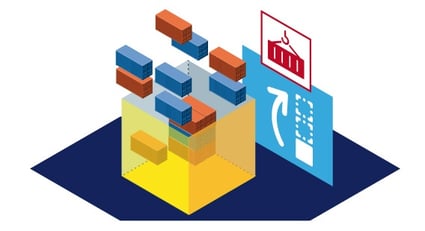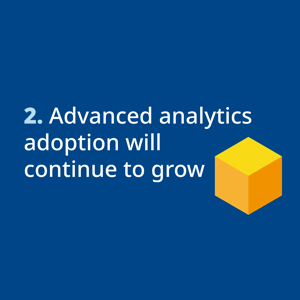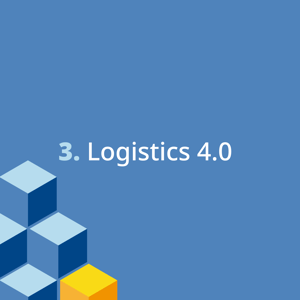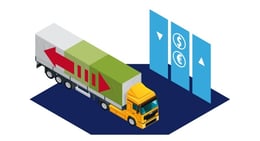5 Logistics Trends to Watch Out For
Brian Hoey - July 05, 2018

As the worlds of manufacturing and retail evolve to meet the unique challenges of the 21st century, logistics (including shipping and freight forwarding) will have to evolve with them. This will likely mean not just a push towards increased digitization, but a continued reimagining of how logistics operates and provides value. Though many of these changes will no doubt seem daunting, they will also present new opportunities for businesses to grow and gain competitive advantages. Here are a few of the most interesting emerging trends to watch out for:
1. Transparency will become increasingly important
 One of the major benefits of digitization in the supply chain has been an increase in overall transparency. As the world of logistics continues to evolve, this boosted transparency will become more than a luxury or a convenient side-benefit—it will become an operational necessity. From the perspective of the consumer, this added degree of visibility is an end in itself, leading to increased trust and a more predictable timetable for deliveries. From the perspective of suppliers, on the other hand, transparency represents an opportunity for more seamless value chain integration, and thus, again, more trust. Though more and more companies have deemed it a necessity in recent years, transparency does not come about automatically. For many businesses, breaking down silos and creating a more connected value chain remain significant roadblocks to visibility.
One of the major benefits of digitization in the supply chain has been an increase in overall transparency. As the world of logistics continues to evolve, this boosted transparency will become more than a luxury or a convenient side-benefit—it will become an operational necessity. From the perspective of the consumer, this added degree of visibility is an end in itself, leading to increased trust and a more predictable timetable for deliveries. From the perspective of suppliers, on the other hand, transparency represents an opportunity for more seamless value chain integration, and thus, again, more trust. Though more and more companies have deemed it a necessity in recent years, transparency does not come about automatically. For many businesses, breaking down silos and creating a more connected value chain remain significant roadblocks to visibility.
2. Advanced analytics adoption will continue to grow
 We’ve discussed the importance of advanced analytics in supply chain management time and time again on this blog, but as the world of logistics becomes more and more intertwined with supply chain management the power of advanced analytics for logistics processes becomes ever more apparent. To wit, many shippers and freight forwarders are finding, and will no doubt continue to find, that the very same predictive and prescriptive analytics processes that are powering the rise of Industry 4.0 have an important role to play in helping them to consolidate freight more effectively, plan and replan shipping routes in a more dynamic manner, and optimize their hub and warehouse usage. And who can argue with the potential added value of process insights that boost efficiency and help to optimize existing workflows?
We’ve discussed the importance of advanced analytics in supply chain management time and time again on this blog, but as the world of logistics becomes more and more intertwined with supply chain management the power of advanced analytics for logistics processes becomes ever more apparent. To wit, many shippers and freight forwarders are finding, and will no doubt continue to find, that the very same predictive and prescriptive analytics processes that are powering the rise of Industry 4.0 have an important role to play in helping them to consolidate freight more effectively, plan and replan shipping routes in a more dynamic manner, and optimize their hub and warehouse usage. And who can argue with the potential added value of process insights that boost efficiency and help to optimize existing workflows?
3. Logistics 4.0
 We’ve already briefly alluded to the intersection of Industry 4.0 and modern logistics, as befits the existing degree of integration between the two paradigms. As Industry 4.0 becomes more of a day-to-day reality, however, we expect that logistics will match the manufacturing world’s technological spirit by fully embracing Logistics 4.0 as the modern standard for smart logistics. Though Logistics 4.0 is not quite as well defined as its industrial counterpart, it involves utilizing elements of Industry 4.0 like internet of thing (IoT) devices, sensors, autonomous workflows, and machine-to-machine communication to create sophisticated cyber-physical systems. While the early benefits of such a trend will likely center around easier integration with Industry 4.0 systems, it’s safe to assume that it will quickly take on a life of its own, creating a more holistic, connected value chain within the logistics sector and providing a sophisticated digital framework to support more efficient functioning from transport management systems. Though reaching this level of connectivity will require organizations to drive towards new heights of visibility and IT cohesion, the end result will be a revolution in the way products make their way from suppliers to consumers.
We’ve already briefly alluded to the intersection of Industry 4.0 and modern logistics, as befits the existing degree of integration between the two paradigms. As Industry 4.0 becomes more of a day-to-day reality, however, we expect that logistics will match the manufacturing world’s technological spirit by fully embracing Logistics 4.0 as the modern standard for smart logistics. Though Logistics 4.0 is not quite as well defined as its industrial counterpart, it involves utilizing elements of Industry 4.0 like internet of thing (IoT) devices, sensors, autonomous workflows, and machine-to-machine communication to create sophisticated cyber-physical systems. While the early benefits of such a trend will likely center around easier integration with Industry 4.0 systems, it’s safe to assume that it will quickly take on a life of its own, creating a more holistic, connected value chain within the logistics sector and providing a sophisticated digital framework to support more efficient functioning from transport management systems. Though reaching this level of connectivity will require organizations to drive towards new heights of visibility and IT cohesion, the end result will be a revolution in the way products make their way from suppliers to consumers.
4. Automation and Robotics
 If we use Industry 4.0 as a benchmark for our expectations, one of the natural outgrowths of a Logistics 4.0 framework should be the rise of autonomous processes and machines making simple decisions. While this may, in the minds of some, conjure futuristic images of self-driving trucks navigating across complex transit routes, the reality of automation in the near future of logistics is much more down to earth. Though the use of autonomous vehicles for shipping purposes may still be a long time in coming, the use of robots in the logistics value chain is already here. These robots are often used in collaboration with other technologies (giving rise to “cobots” as a moniker) or with human workers, and they are already helping to automate tasks in shipping and fulfillment. We predict that much of the increased automation in fulfillment in the coming years will look like this.
If we use Industry 4.0 as a benchmark for our expectations, one of the natural outgrowths of a Logistics 4.0 framework should be the rise of autonomous processes and machines making simple decisions. While this may, in the minds of some, conjure futuristic images of self-driving trucks navigating across complex transit routes, the reality of automation in the near future of logistics is much more down to earth. Though the use of autonomous vehicles for shipping purposes may still be a long time in coming, the use of robots in the logistics value chain is already here. These robots are often used in collaboration with other technologies (giving rise to “cobots” as a moniker) or with human workers, and they are already helping to automate tasks in shipping and fulfillment. We predict that much of the increased automation in fulfillment in the coming years will look like this.
5. Anticipatory Logistics
 If there is a unifying theme to the logistics trends we’ve been outlining, it’s that logistics as a field will be a site of continuing evolution. Even if individual trends don’t pan out the way we expect, we’re confident that change will be a constant force as logistics strives to keep pace with other evolving industries. As these changes occur, the world will get closer and closer to the era of anticipatory logistics. Anticipatory logistics, which involves predicting both demand and disruptions in advance in order to create a value chain that seamlessly anticipates and meets customer demand, thereby reducing lead times and inventory requirements, may seem like a lofty goal now, but if all of these trends continue we can expect to see its emergence in the not-too-distant future.
If there is a unifying theme to the logistics trends we’ve been outlining, it’s that logistics as a field will be a site of continuing evolution. Even if individual trends don’t pan out the way we expect, we’re confident that change will be a constant force as logistics strives to keep pace with other evolving industries. As these changes occur, the world will get closer and closer to the era of anticipatory logistics. Anticipatory logistics, which involves predicting both demand and disruptions in advance in order to create a value chain that seamlessly anticipates and meets customer demand, thereby reducing lead times and inventory requirements, may seem like a lofty goal now, but if all of these trends continue we can expect to see its emergence in the not-too-distant future.
LATEST POSTS
- Understand Why Production Planning Needs Specialized Solutions
- Understand Circular Economy in The Manufacturing Industry
- How Can Industry 4.0 IT Integration Be Achieved Smoothly?
- The Significance of Order Sequencing in Discrete Manufacturing
- How to improve your Supply Chain Management: The Power of Control Towers



